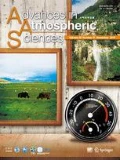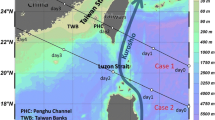Abstract
The upper-ocean responses to Typhoon Megi (2010) are investigated using data from ARGO floats and the satellite TMI. The experiments are conducted using a three-dimensional Princeton Ocean Model (POM) to assess the storm, which affected the Northwest Pacific Ocean (NWP) and the South China Sea (SCS). Results show that the upwelling and entrainment experiment together account for 93% of the SST anomalies, where typhoon-induced upwelling may cause strong ocean cooling. In addition, the anomalous SST cooling is stronger in the SCS than in the NWP. The most striking feature of the ocean response is the presence of a two-layer inertial wave in the SCS—a feature that is absent in the NWP. The near-inertial oscillations can be generated as typhoon wakes, which have maximum flow velocity in the surface mixed layer and may last for a few days, after the typhoon’s passage. Along the typhoon tracks, the horizontal currents in the upper ocean show a series of alternating negative and positive anomalies emanating from the typhoon.
Similar content being viewed by others
References
Antonov, J. A., R. A. Locarnini, T. P. Boyer, H. E. Garcia, and A. V. Mishonov, 2006: Salinity. Vol. 2, World Ocean Atlas 2005, NOAA Atlas NESDIS 62, Levitus, S, Ed., U.S. Government Printing Office, Washington, D.C., 182 pp.
Bender, M. A., and I. Ginis, 2000: Real-case simulations of hurricane-ocean interaction using a high-resolution coupled model: Effects on hurricane intensity. Mon. Wea. Rev., 128, 917–946, doi: 10.1175/1520-0493(2000)128<0917: RCSOHO>2.0.CO;2.
Chang, S.W., and R. A. Anthes, 1979: The mutual response of the tropical cyclone and the ocean. J. Phys. Oceanogr., 9, 128–135, doi: 10.1175/1520-0485(1979)009<0128:TMROTT>2.0.CO;2.
Chen, X. Y., D. L. Pan, X. Q. He, Y. Bai, and D. F. Wang, 2012: Upper ocean responses to category 5 typhoon Megi in the western north Pacific. Acta Oceanologica Sinica, 31(1), 51–58.
Chiang, T.-L., C.-R. Wu, and L.-Y. Oey, 2011: Typhoon Kai-Tak: An ocean’s perfect storm. J. Phys. Oceanogr., 41, 221–233.
Choi, Y., K.-S. Yun, K.-J. Ha, K.-Y. Kim, S.-J. Yoon, and J. C. L. Chan, 2013: Effects of asymmetric SST distribution on straight-moving typhoon Ewiniar (2006) and recurving typhoon Maemi (2003). Mon. Wea. Rev., 141, 3950–3967, doi: 10.1175/MWR-D-12-00207.1.
Chu, P. C., J. M. Veneziano, C. W. Fan, M. J. Carron, and W. T. Liu, 2000: Response of the south China sea to tropical cyclone Ernie 1996. J. Geophys. Res., 105(C6), 13991–14009.
Da Silva, A., A. C. Young, and S. Levitus, 1994: Atlas of Surface Marine Data 1994. NOAA Atlas NESDIS 9, U.S. Department of Commerce, NOAA, NESDIS, 308 pp.
Elsberry, R. L., T. Fraim, and R. N. Trapnell, 1976: A mixed layer model of the oceanic thermal response to hurricanes. J. Geophys. Res., 81, 1153–1162.
Elsner, J. B., S. E. Strazzo, T. H. Jagger, T. LaRow, and M. Zhao, 2013: Sensitivity of limiting hurricane intensity to SST in the Atlantic from observations and GCMs. J. Climate, 26, 5949–5957, doi: 10.1175/JCLI-D-12-00433.1
Fisher, E. L., 1958: Hurricanes and the sea-surface temperature field. J. Meteor., 15, 328–333.
Garrett, C., 2001: What is the “near-inertial” band and why is it different from the rest of the internal wave spectrum. J. Phys. Oceanogr., 31(4), 962–971.
Geisler, J. E., 1970: Linear theory of the response of a two layer ocean to a moving hurricane. Geophys. Fluid Dyn., 1, 249–272.
Gill, A. E., 1984: On the behavior of internal waves in the wakes of storms. J. Phys. Oceanogr., 14, 1129–1151.
Gjevik, B., 1991: Simulations of shelf sea response due to travelling storms. Cont. Shelf Res., 11(2), 136–166.
Gjevik, B., and M. A. Merrifield, 1993: Shelf-sea response to tropical storms along the west coast of Mexico. Cont. Shelf Res., 13(1), 25–47.
Greatbatch, R. J., 1985: On the role played by upwelling of water in lowering sea surface temperatures during the passage of a storm. J. Geophys. Res., 20, 11751–11755.
Guan, S. D., W. Zhao, J. Huthnance, J. W. Tian, and J. H. Wang, 2014: Observed upper ocean response to typhoon Megi (2010) in the Northern South China Sea, J. Geophys. Res., 119, 3134–3157, doi: 10.1002/2013JC009661.
Halpern, D., 1974: Observations of the deepening of the wind-mixed layer in the northeast Pacific Ocean. J. Phys. Oceanogr., 4, 454–466.
Kalnay, E, and Coauthors, 1996: The NCEP/NCAR 40-year reanalysis project. Bull. Amer. Meteor. Soc., 77, 437–470.
Ko, D. S., S.-Y. Chao, C.-C. Wu, and I.-I. Lin, 2014: Impacts of typhoon Megi (2010) on the South China Sea. J. Geophys. Res., 119, 4474–4489, doi: 10.1002/2013JC009785.
Large, W. G., and G. B. Crawford, 1995: Observations and simulations of upper-ocean response to wind events during the Ocean Storms Experiment, J. Phys. Oceanogr., 25, 2831–2852.
Leiper, D. F., 1967: Observed ocean conditions and hurricane Hilda, 1964. J. Atmos. Sci., 24, 182–196.
Levitus, S., 1982: Climatological Atlas of the World Ocean. NOAA Professional Paper No. 13, 191 pp.
Lin, I.-I., 2012: Typhoon-induced phytoplankton blooms and primary productivity increase in the western North Pacific subtropical ocean. J. Geophys. Res., 117, C03039, doi: 10.1029/2011JC007626.
Lin, I.-I., and Coauthors, 2003a: New evidence for enhanced ocean primary production triggered by tropical cyclone, Geophys. Res. Lett., 30(13), 1718, doi: 10.1029/2003GL017141.
Lin, I.-I., W. T. Liu, C.-C. Wu, J. C. H. Chiang, and C.-H. Sui, 2003b: Satellite observations of modulation of surface winds by typhoon-induced upper ocean cooling. Geophys. Res. Lett., 30, 1131, doi: 10.1029/2002GL015674.
Liu L., J. F. Fei, X. P. Cheng, and X. G. Huang, 2013: Effect of wind-current interaction on ocean response during Typhoon KAEMI (2006). Science China Earth Sciences, 56(3), 418–433.
Locarnini, R. A., A. V. Mishonov, J. I. Antonov, T. P. Boyer, and H. E. Garcia, 2006: Temperature. Vol. 1, World Ocean Atlas 2005, NOAA Atlas NESDIS 61, L. Levitus, Ed., U.S. Government Printing Office, Washington, D.C., 182 pp.
Mei, W., and C. Pasquero, 2013: Spatial and temporal characterization of sea surface temperature response to tropical cyclones. J. Climate, 26, 3745–3765, doi: 10.1175/JCLI-D-12-00125.1.
Mei, W., M. Lie, I.-I. Lin, and S.-P. Xie, 2015b: Tropical cycloneinduced ocean response: A comparative study of the South China Sea and tropical Northwest Pacific. J. Climate, 28(15), 5952–5968, doi: 10.1175/JCLI-D-14-00651.1.
Mei, W., S.-P. Xie, M. Zhao, and Y. Q. Wang, 2015a: Forced and internal variability of tropical cyclone track density in the western North Pacific. J. Climate, 28, 143–167, doi: 10.1175/JCLI-D-14-00164.1.
Miller, B. J., 1964: A study of the filling of Hurricane Donna (1960) over land. Mon. Wea. Rev., 92, 389–406.
Millot, C., and M. Crépon, 1981: Inertial oscillations on the continental shelf of the gulf of lions-observations and theory. J. Phys. Oceanogr., 11, 639–657, doi: 10.1175/1520-0485 (1981)011<0639:IOOTCS>2.0.CO;2.
Morey, S. L., M. A. Bourassa, D. S. Dukhovskoy, and J. J. O’Brien, 2006: Modeling studies of the upper ocean response to a tropical cyclone. Ocean Dynamics, 56, 594–606, doi: 10.1007/s10236-006-0085-y.
O’Brien, J. J., 1967: The non-linear response of a two-layer, baroclinic ocean to a stationary, axially-symmetric hurricane: Part II. Upwelling and mixing induced by momentum transfer. J. Atmos. Sci., 24, 208–215.
O’Brien, J. J., and R. O. Reid, 1967: The non-linear response of a two-layer, baroclinic ocean to a stationary, axially-symmetric hurricane: Part I. Upwelling induced by momentum transfer. J. Atmos. Sci., 24, 197–207.
Oey, L.-Y., M. Inoue, R. Lai, X.-H. Lin, S. E. Welsh, and L. J. Rouse, 2008: Stalling of near-inertial waves in a cyclone, Geophys. Res. Lett., 35, L12604, doi: 10.1029/2008GL034273.
Price, J. F., 1981: Upper ocean response to a hurricane. J. Phys. Oceanogr., 11, 153–175.
Price, J. F., T. B. Sanford, and G. Z. Forristall, 1994: Forced stage response to a moving hurricane. J. Phys. Oceanogr., 24, 233–260.
Sakaida, F., H. Kawamura, and Y. Toba, 1998: Sea surface cooling caused by typhoons in the Tohoku Area in August 1989. J. Geophys. Res., 103(C1), 1053–1065.
Shang, S. L., and Coauthors, 2008: Changes of temperature and bio-optical properties in the South China Sea in response to typhoon Lingling, 2001. Geophys. Res. Lett., 35, L10602, doi: 10.1029/2008GL033502.
Shay, L. K., and R. L. Elsberry, 1987: Near-inertial ocean current response to hurricane Frederic. J. Phys. Oceanogr., 17, 1249–1269.
Shay, L. K., P. G. Black, A. J. Mariano, J. D. Hawkins, and R. L. Elsberry, 1992: Upper ocean response to Hurricane Gilbert. J. Geophys. Res., 97, 20227–20248.
Slutz, R. J., S. J. Lubker, J. D. Hiscox, S. D. Woodruff, R. L. Jenne, D. H. Joseph, P. M. Steurer, and J. D. Elms, 1985: COADS (comprehensive ocean-atmosphere data set), Release 1. NOAA Environmental Research Laboratories, CIRES University of Colorado, 300 pp.
Stramma, L., P. Cornillon, and J. F. Price, 1986: Satellite observations of sea surface cooling by hurricanes. J. Geophys. Res., 91(C4), 5031–5035.
Tsai, Y., C.-S. Chern, and J. Wang, 2012: Numerical study of typhoon-induced ocean thermal content variations on the northern shelf of the South China Sea. Cont. Shelf Res., 42, 64–77.
Tseng, Y.-H., S. Jan, D. E. Dietrich, I.-I. Lin, Y.-T. Chang, and T.-Y. Tang, 2010: Modeled oceanic response and sea surface cooling to typhoon Kai-Tak. Terrestrial, Atmospheric and Oceanic Sciences, 21, 85–98, doi: 10.3319/TAO.2009.06.08.02(IWNOP).
Wang, J. C., J. Zhang, and J. G. Yang, 2014: Numerical simulation and preliminary analysis on ocean waves during Typhoon Nesat in South China Sea and adjacent areas. Chinese Journal of Oceanology and Limnology, 2014, 32(3), 665–680.
Yablonsky, R. M., and I. Ginis, 2009: Limitation of onedimensional ocean models for coupled hurricane-ocean model forecasts. Mon. Wea. Rev., 137, 4410–4419, doi: 10.1175/2009MWR2863.1
Yang, Y.-J., L. Sun, A.-M. Duan, Y.-B. Li, Y.-F. Fu, Y.-F. Yan, Z.- Q. Wang, and T. Xian, 2012: Impacts of the binary typhoons on upper ocean environments in November 2007. Journal of Applied Remote Sensing, 6, 063583, doi: 10.1117/1.JRS.6.063583.
Yun, K.-S., J. C. L. Chan, and K.-J. Ha, 2012: Effects of SST magnitude and gradient on typhoon tracks around East Asia: a case study for Typhoon Maemi (2003). Atmospheric Research, 109-110, 36–51.
Zedler, S. E., T. D. Dickey, S. C. Doney, J. F. Price, X. Yu, and G. L. Mellor, 2002: Analyses and simulations of the upper ocean’s response to Hurricane Felix at the Bermuda Testbed Mooring site: 13–23 August 1995. J. Geophys. Res., 107(C12), 25-1–25-29, doi: 10.1029/2001JC000969.
Acknowledgments
The authors are grateful to the two anonymous reviewers for their helpful comments. This work was supported by the National Key Basic Research and Development Plan (Grant No. 2015CB953900), the National Natural Science Foundation of China (Grant No. 41176005), the Public Science and Technology Research Funds Projects of the Ocean (Grant No. GYHY201105018), and the China R&D Special Fund for Public Welfare Industry (GYHY 201306016).
Author information
Authors and Affiliations
Corresponding author
Rights and permissions
About this article
Cite this article
Li, ZL., Wen, P. Comparison between the response of the Northwest Pacific Ocean and the South China Sea to Typhoon Megi (2010). Adv. Atmos. Sci. 34, 79–87 (2017). https://doi.org/10.1007/s00376-016-6027-9
Received:
Revised:
Accepted:
Published:
Issue Date:
DOI: https://doi.org/10.1007/s00376-016-6027-9



